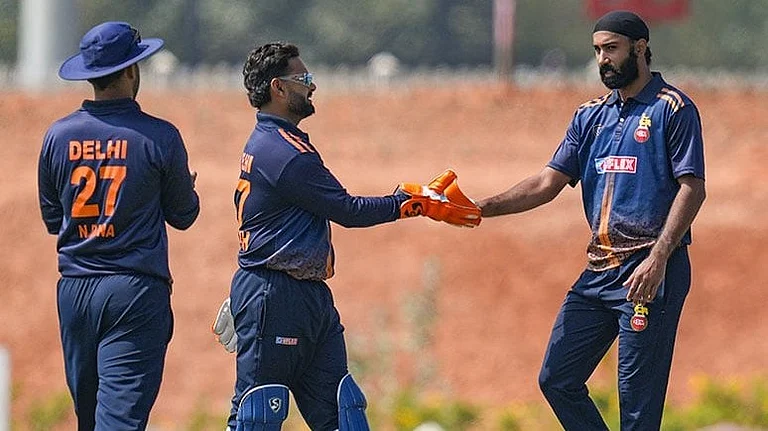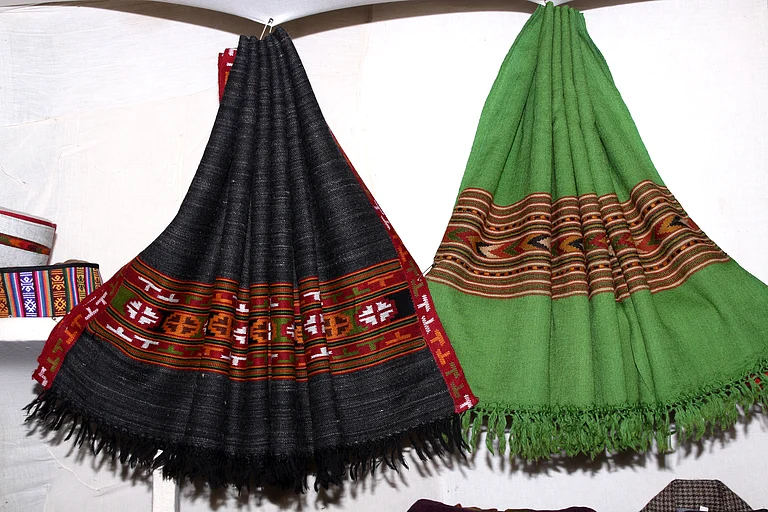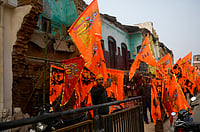The black four-horned khadu (ram) stood somewhat lost in the crowd. Bedecked in red and saffron with garlands around its neck and bags full of jewellery tied to its back, it seemed totally oblivious of its significant role. A role it has been playing for about 900 years now.
A year before the commencement of the ‘Raj Jat’ or the Himalayan Kumbh, priests from Nauti, a village in the Garhwal hills, assemble and plead the gods for the birth of this four-horned ram. And if such a ram isn’t born, the ‘yatra’ doesn’t take off. Not every four-horned ram fits the bill; preferably black in colour, it should be born around Basant Panchami (a festival that falls in January-February). Explains Bhuwan Nautiyal of the ancient Raj Guru family, who is the head priest of the Raj Jat, "It is meant to be Nanda Devi’s escort as she returns to her husband Shiva’s abode after a brief visit to her mait (parent’s house)." The ram in fact leads the procession as it makes its way through the rough hill terrain for 19 days. During this period, this ‘sheep’ is fed on bread alone. "This is a holy meal also offered to the gods. The ram gives up on the usual frugal feed of grass and leaves," clarifies the priest. The two extra horns, believe the hill people, help the ram choose the right and ideal path as it carries the Goddess back to her husband’s house. At the end of the journey, this six-month-old sheep is left all to itself. The ram walks off into the wilderness and the procession returns after the last halt at Homkund. And after its trek of glory, this ceremonial four-legged creature is never seen again.
This Raj Jat dates back to the 12th century. King Yashdhaval of Kannauj had married Vallabha, the daughter of the king of Chandpur (capital of Garhwal), and according to the hymns and folk songs that are chanted during this festival, the Goddess Nanda, unhappy with the queen’s irreverence for Her, had cursed her. As a consequence her kingdom suffered drought, famine and disease. The Raj Gurus then advised the king to go ahead to the Raj Jat with a four-horned ram. A journey he and his family then undertook. Today, remembering that journey, some of the place-names on the way are linked to the tragic incidents that struck the Yashdhavals as they moved towards their destination. A place called Ballawa Swelida (delivery cave) has a cave where the queen gave birth to a stillborn child. Further up, Pathar Nachaouni (stone dancers) reminds the pilgrims how all the accompanying dancers had turned to stones after a blizzard. Even the lake near the final destination is still reputed to contain skeletons and hair. Says Gajendra Nautiyal, who teaches in a college in Dehradun, "In my previous journey I too put in my hand and felt bones and hair in the lake." This ice-covered lake, Roop Kund, seems to have been the last spot visited by the king’s family, and they are said to have been buried in an avalanche here.
After this, it was Raja Ajay Pal of Chand Garh, who once again started the journey in the 15th century. Since then, members of the royal family (Kunwars) with their pandits (Nautiyals) have carried on with the tradition. Says Rakesh Singh Kunwar, who is representing the royals this time, "During this festival we also seek forgiveness on behalf of our ancestors." Keeping with tradition, the journey this year also began from Nauti, the village of the Nautiyals, situated at a height of 5,800 feet.
But this year, ‘modernity’ left its mark on the ancient route: tea-stalls serving Chinese food, Coca Cola banners welcoming the devotees, hastily set-up telephone booths, guest houses were constructed, camps set up and temples and gateways were given a facelift. Reminiscences 86-year-old Dr S.P. Nautiyal who’d braved the journey in 1987, "Such things were unimaginable then. These changes only speak of the rising popularity of this festival."
A day before the procession, a special ceremony where offerings are made to the ram was held in a village 12 km from Nauti. This village, where the ram actually begins its personal journey, is called Kansua. In the local Garhwali dialect, the brother of a king is referred to as Kansa, hence the village’s name. It is said that a seventh-generation king, Shali Pal, finding little time to devote to the procession, entrusted the job to his brother, whose descendants still comprise the population of the entire village.
But before the trek, the ram is first worshipped. To begin with, it is placed in front of a temple that displays plaques of Nanda Devi, Shiva and Lord Hanuman. It is then anointed with turmeric and vermilion and given an offering of rice, flowers and fruits. Devotees crowd around asking for blessings from the Goddess. All through, the priests keep a keen eye on the holy animal - no one is allowed to touch it. Once the prayers are over, the drummers hype the festive mood. Jagars (men who sing songs to hail the goddess) and women folk singers also join in. In no time, men leave their seats and stand in a circle. With hands behind their heads, they tap their feet in unison to the drumbeats and cries of Jai Nanda Devi ki begin to rent the hills. Once in while, a man goes into a trance - running uncontrollably, hair flying in the wind, eyes a burning red, he dances with unbelievable vigour and shouts out aloud. "He is possessed by the divine," is the common interpretation. With folded hands people touch his feet in reverence as he showers them with rice as a blessing. These ‘possessed’ men and women are seen all through the journey. At Nauti, one of them even pulls out red-hot charcoal from the ‘holy fire’ and dances holding it in his hands. As the spell wears off, most of the ‘possessed’ fall down listlessly.
While some men and women brave the tough journey till the last spot, others accompany the procession to just a few villages, while many others welcome it with fruits and flowers on the way up to the holy hills. The entire journey will take 19 days and the procession is scheduled to stop at 18 different villages to pay homage to the different forms of the Goddess in the small hill temples. The final terrain from Vedni Bugiyal (The Holy Meadow) is the most difficult stretch. Pilgrims from previous journeys say that crossing over to another peak at Jura Gali (the path of death) "gives the shivers". Ritually, villagers from a nearby hamlet, Kanol, help out in this task. They go to the opposite cliff and help the pilgrims over - sometimes they have to physically drag people over. The two mountains are separated by a gap of just two feet. "If one slips, it’s a free-fall to Roopkund, 1,500 feet below," says Gajendra.
In contrast, the return journey takes just two days, even the route is different. And once the ram is left on its own, the Nautiyals and Kunwars do not turn back to see where it’s going. "It will obviously reach Trishul peak where Lord Shiva stays," says a bystander, Himani Devi, with finality. Faith has its own ways.























